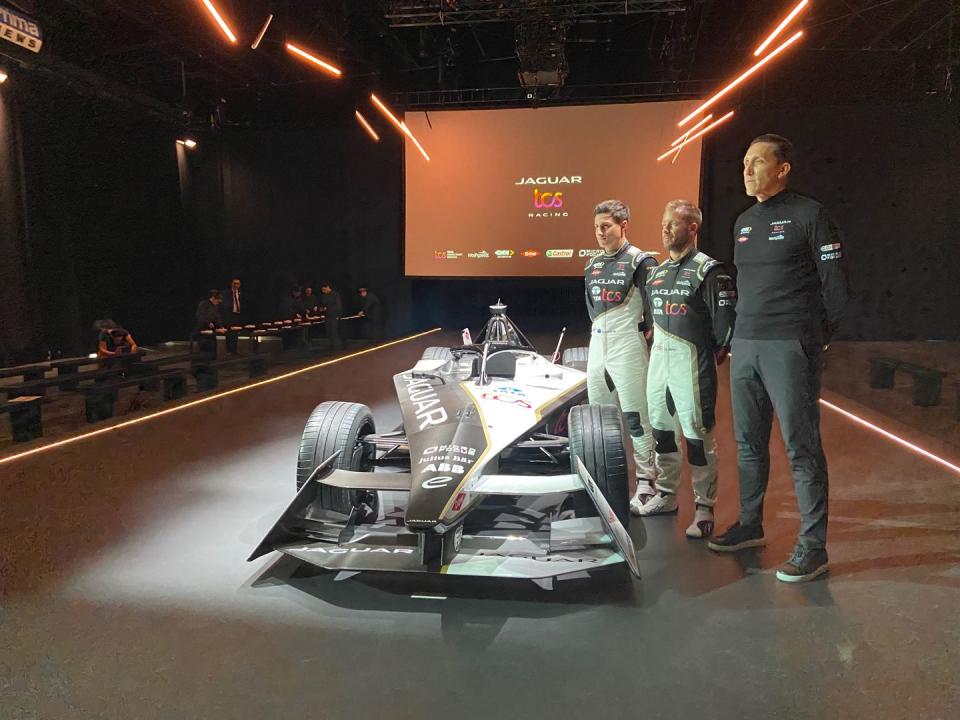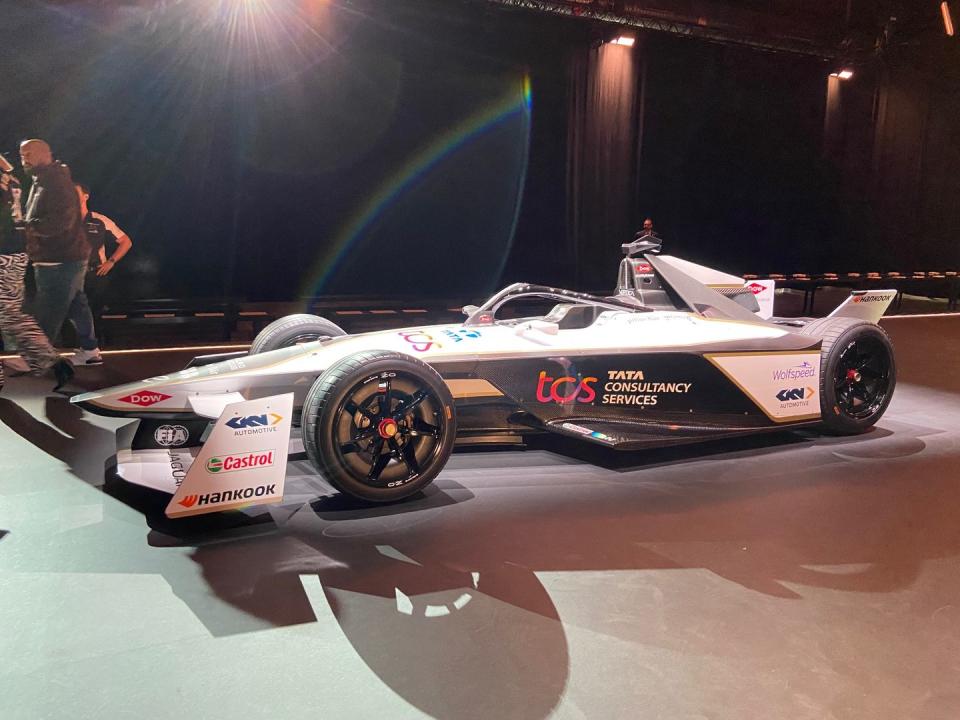How ABB Formula E Series Plans to Take EV Performance, Open-Wheel Racing to Next Level

This past week, the teams of the Formula E all-electric, open-wheel series began showing off their new machines for the 2023 season.
The 2023 Gen 3 cars will boast more power and more efficiency.
Race rans will see, but still barely hear, the whir of EVs going up t0 200 mph on long straights.
Formula E teams are ready to kick things up a notch in 2023.
This past week, the teams of the all-electric, open-wheel series began showing off their new machines for the 2023 season. It's a season that will feature the sport's so-called Generation 3 cars.
And while Gen 3 will not be breaking new range barriers that might get the attention of car buyers dealing with range anxiety in their local EV showroom, the faster speeds and increased manufacturer involvement in the latest version of open-wheel race cars should open some eyes.
Range has been a go-to headline for the series since its debut in 2014. The first generation Formula E car, much like early EVs for the road, had limited range. Drivers in Formula E racers even had to swap cars midway through the 20-30 minute races to make it to the finish line.
Generation 2 for the series' fifth season in 2018 featured cars competing the 45-minute plus-one lap races without the mid-race swap. Cars topped out at about 180 mph. That started getting the series and the Formula E technology a little more notice from Main Street.
This time around in 2023, the schedule calls for the same 45-minute races. The cars, however, will boast more power and more efficiency. Race rans will see, but still barely hear, the whir of cars approaching 200 mph on long straights—up from this past year's nearly 180 mph top-end speed.
The series is maturing nicely.

"It's still a very young championship, but it's growing at an incredible rate," James Barclay, managing director, Jaguar Land Rover Motorsport and team principal of the Jaguar TCS Racing Formula E Team, told Autoweek in London. "The interest we're seeing from partners, from sponsors, from media, is really ramping up.
"At the heart of it is the electric powertrain technology which is going to be more relevant to all of us now and even more so in the future."
Barclay, along with the team's veteran Formula E drivers, Sam Bird and Mitch Evans, were center stage for the reveal of the Jaguar TCS Racing's I-Type 6 car on London's westside on Nov. 30. While Jaguar wasn't involved in Formula E from the beginning of Gen 1, Barclay has had his eyes on the series since its formation in 2014.
"I went to the original launch of the series, and we were just scoping out potential future (racing) categories for Jaguar to return to motorsport," Barclay said. "At the heart of it was a very interesting set of ingredients. You look at something like the Paris climate change convention in September, 2015. It was the first time we had a book on certain countries where you wouldn't be able to sell internal combustion engine cars. The future was now clear.
"Our view was that the Formula E—the pinnacle electric world championship—was moving into the bullseye. It's safe to say that since that point in 2015 to now we've just seen the championship continue to go parallel with a massively changed industry."

And that means a massively changed racing series since the one started by Alejandro Agag and signed off on by then FIA president Jean Todt nearly a decade ago. Jaguar jumped into the series in 2016.
"What was interesting at that time, the range limitations weren't actually a limitation on technology, it was actually just the limitation of originally the series was designed for 20-minute races," Barclay said. "Then, we found we needed to be closer to an hour for a race to be really exciting, so we actually needed two cars.
"The first generation was to prove you could race electric cars. Generation 2 was about saying let's make the cars faster, let's make cars that will do the full race and race faster with greater efficiency, greater range and make better sport. We saw a world championship with some of the best manufacturers, best teams, best drivers and great racing and great cities—iconic cities like Hong Kong, Paris, New York.
"And now Gen 3 is about saying, 'Let's go faster again. Let's be more powerful, more efficient and really challenge efficiency targets."
This coming season, the series will be bringing its message to new racing destinations, including Sao Paulo, Cape Town, South Africa and Hyderabad, India. Tokyo plans to host a race in 2024. New York is not on the provisional 2023 schedule, but series organizers are still hopeful of a race in the U.S. in '23. Two dates on that schedule are still listed as TBC (To Be Confirmed).
Manufacturers along for the ride next season in addition to Jaguar, include Porsche, Nissan, NIO from China, Maserati, Mahindra and DS Automobiles from France. Maserati is new to the series. Tire supplier Hankook is also new to Formula E for next season.
REVEALED pic.twitter.com/r1tl33WaER
— Jaguar TCS Racing (@JaguarRacing) December 1, 2022
"We've got lots of new toys to play with in the the new car," said Phil Charles, Jaguar TCS Racing's technical manager. "First and foremost is power. Gen 2, we had 250 kilowatt maximum power on the rear axle. When we go to Gen 3, we've got 350 kilowatt maximum. That's massive.
"The next thing is there are drive shafts on the front of the car. So, for the first time, we've got a motor—a power train—on the front axle. This motor doesn't drive the car, but it is used in braking. "
Charles says the braking system just adds to an already efficient car.
"In Gen 2, we were squeezing pads on disks and burning energy," he said. "Now, we've got the capability to do a bit of that, but also we can recharge that energy back into the battery. That's a big step for the championship. We're recovering more energy every time we hit the brake."
The chassis for all the teams is stock. FIA determines the bodywork and aerodynamics. Williams Engineering supplies the batteries to all teams.
What the teams do have control over is the powertrain.
"All of our efforts go into developing the energy, the motor generator unit (MGU), the inverter, the gearbox, the driveshafts, the suspension and the carbon maintenance," Charles said.
The question begs. Is Formula E ready for prime time, ready to show off its product to a larger audience? Instead of say, the current summer weekend on a makeshift road course in Brooklyn before maybe 20,000 people, how about joining up with Formula 1 and becoming a support series on an F1 Saturday before say 110,000 at Circuit of the Americas in Austin? Or, how about showing off Formula E to the world's F1 fans at Las Vegas or Miami?
Charles says that the series has never been more ready, on the technology side, anyway. On the other hand, team principal Barclay is happy with the lane the series is currently driving in.
"So, we'll never be a Saturday show, I don't believe so," Barclay said. "That's my view. Why am I saying that? It's because we're just different. Formula 1 is the pinnacle of ICE hybrid racing, Formula E is the pinnacle of electric racing. And I think the two have merit to have their own show.
"That doesn't mean we can't work cleverly in synergies in other areas. And absolutely, I think that could be really an area of interest potentially in the future. Liberty Media owns Formula 1 and has a majority stake in Formula E, as well. So, from that point of view, I think there are future synergies."
Barclay pointed out the Formula E actually has some built-in advantages over Formula 1 when it comes to racing in many places on the world's stage.
"One thing is, we can go racing in really unique locations because of the benefit of zero emissions and reduced noise," Barclay said. "I think we as a championship will continue to find our ideal format. The idea of racing in city centers still stands, but I think what we do have is a sport which will continue to evolve, continue to get faster, continue to showcase amazing racing."
Season 9. Let’s go 🔥
— ABB FIA Formula E World Championship (@FIAFormulaE) November 28, 2022
